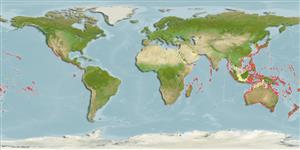Classification / Names
Common names from other countries
Main reference
Size / Weight / Age
Max length : 180 cm SL male/unsexed; (Ref. 9710); 124.0 cm SL (female); common length : 100.0 cm SL male/unsexed; (Ref. 9814); max. published weight: 14.0 kg (Ref. 9814); max. reported age: 15 years (Ref. 9814)
Length at first maturity
Lm 91.8, range 68 - 70 cm
Environment
Marine; freshwater; brackish; benthopelagic; amphidromous (Ref. 51243); depth range 1 - 30 m (Ref. 6898), usually ? - 15 m (Ref. 89972)
Climate / Range
Tropical; 15°C - 43°C (Ref. 43081), preferred 26°C (Ref. 107945); 46°N - 52°S, 19°E - 77°W
Distribution
Indo-Pacific: along continental shelves and around islands, where temperatures are greater than 20°C. Red Sea and South Africa to Hawaii and the Marquesas, north to Japan, south to Victoria, Australia. Eastern Pacific: San Pedro, California to the Galapagos.
Countries | FAO areas | Ecosystems | Occurrences | Introductions
Short description
Dorsal
spines
(total): 2;
Dorsal
soft rays
(total): 13-17;
Anal
spines: 2;
Anal
soft rays: 8 - 10;
Vertebrae: 46. This species is characterized by the following: body elongate and somewhat compressed; mouth small and toothless; branchiostegal rays 4; one dorsal fin; pectoral fins falcate; body olive green; flanks silvery; fins dark bordered (Ref. 55763). Superficially resembles bonefishes but by evolution more advanced by having 4 branchiostegal rays (Ref. 1602); jaws toothless (Ref. 12693); with 31 caudal fin rays (Ref. 50686).
IUCN Red List Status (Ref. 115185)
Threat to humans
Harmless
Human uses
Fisheries: highly commercial; aquaculture: commercial; gamefish: yes; bait: usually
Tools
Special reports
Download XML
Internet sources
Estimates of some properties based on models
Phylogenetic diversity index
PD50 = 1.5000 many relatives (e.g. carps) 0.5 - 2.0 few relatives (e.g. lungfishes)
Trophic Level
2.4 ±0.20 se; Based on food items.
Resilience
Low, minimum population doubling time 4.5 - 14 years (tm=4-8; tmax=15; Fec=200,000)
Vulnerability
Very high vulnerability (76 of 100)
Price category
